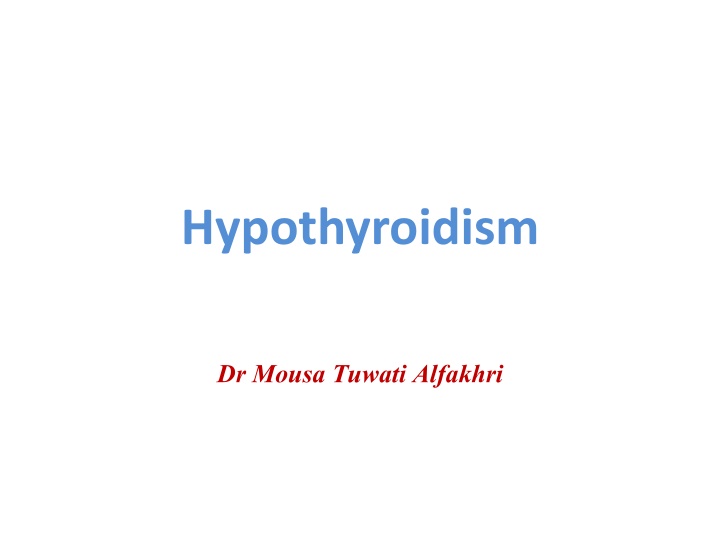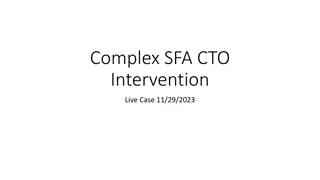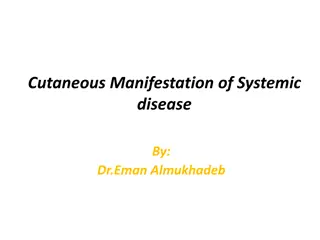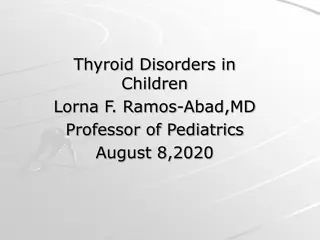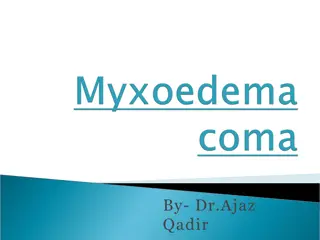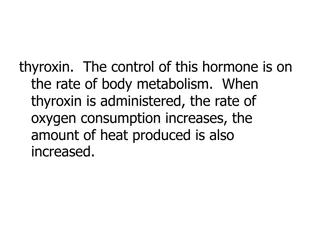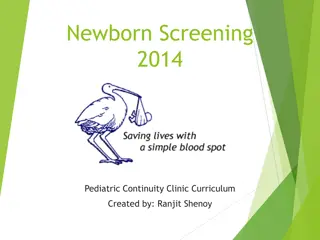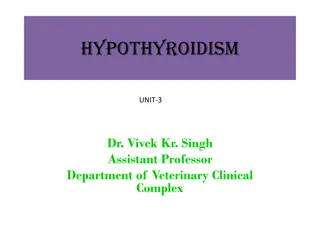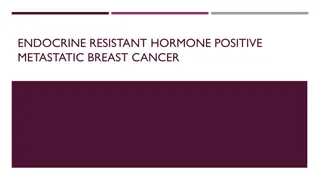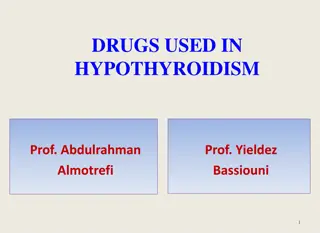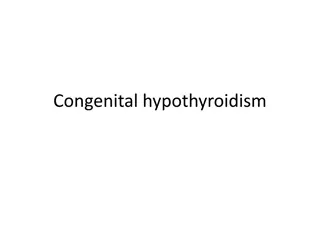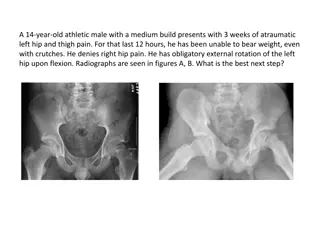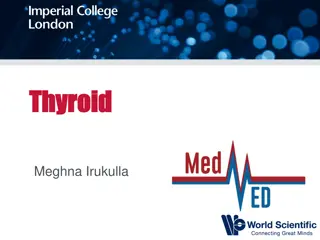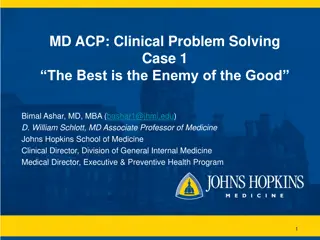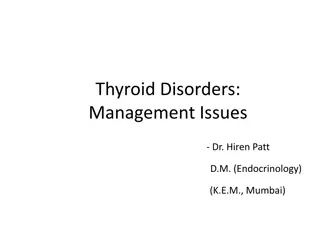Hypothyroidism
Hypothyroidism is a common condition characterized by underactivity of the thyroid gland, leading to various symptoms such as weight gain, fatigue, and dry skin. It can be caused by factors like autoimmune diseases, iodine deficiency, and certain medications. Hashimoto's thyroiditis, a type of autoimmune thyroid disease, is a major cause of hypothyroidism, especially in women. Recognizing the symptoms of hypothyroidism is crucial for early diagnosis and management.
Download Presentation

Please find below an Image/Link to download the presentation.
The content on the website is provided AS IS for your information and personal use only. It may not be sold, licensed, or shared on other websites without obtaining consent from the author.If you encounter any issues during the download, it is possible that the publisher has removed the file from their server.
You are allowed to download the files provided on this website for personal or commercial use, subject to the condition that they are used lawfully. All files are the property of their respective owners.
The content on the website is provided AS IS for your information and personal use only. It may not be sold, licensed, or shared on other websites without obtaining consent from the author.
E N D
Presentation Transcript
Hypothyroidism Dr Mousa Tuwati Alfakhri
Hypothyroidism Hypothyroidism is Underactivity of the thyroid gland usually primary, from disease of the thyroid, but may be secondary to hypothalamic pituitary disease (reduced TSH drive) Primary hypothyroidism is one of most common endocrine conditions with overall UK prevalence of over 2% in women, but under 0.1% in men
Causes of hypothyroidism Autoimmune Hashimoto s thyroiditis Spontaneous atrophic hypothyroidism Iatrogenic Radioactive iodine ablation Thyroidectomy Drugs(Carbimazole,propylthiouracil,Amiodarone,Lithium) Transient thyroiditis Subacute (de Quervain s) thyroiditis Post-partum thyroiditis
Other Causes of hypothyroidism Iodine deficiency e.g. in mountainous Regions Congenital Dyshormonogenesis Thyroid aplasia Infiltrative Amyloidosis, Riedel s thyroiditis,Sarcoidosis Secondary hypothyroidism TSH deficiency secondary to hypothalamic pituitary disease (reduced TSH drive)
Hashimotos Thyroiditis Hashimoto s thyroiditis is commom cause of hypothyroidism and goitre( usually firm ) more common in women and most common in late middle age autoimmune disease involves heavy infiltration of lymphocytes that totally destroys normal thyroidal architecture TPO antibodies are present, often in very high titres Patientsmay be hypothyroid or euthyroid, though they may go through an initial toxic phase,( Hashi-toxicity) familial and may be associated with other autoimmune diseases such as pernicious anemia, adrenocortical insufficiency, idiopathic hypoparathyroidism, and vitiligo. Shmidt s syndrome consists of Hashimoto s thyroiditis, adrenal insufficiency, hypoparathyroidism, DM, ovarian failure, and candidal infections.
Symptoms of hypothroidism Puffy eyes Dry, brittle unmanageable hair Dry, coarse skin Arthralgia Myalgia Muscle weakness/Stiffness Constipation Menorrhagia or oligomenorrhoea in women Psychosis Coma Deafness Tiredness/malaise Weight gain Anorexia Cold intolerance Poor memory Change in appearance Depression Poor libido Goitre
Signs of hypothyroidism Hypertension Hypothermia Heart failure Proximal myopathy Bradycardia, pericardial effusion ,pleural effusion Slow-relaxing reflexes Anaemia Carpal tunnel syndrome Non-pitting oedema (myxoedema) Mental slowness Psychosis/dementia Periorbital oedema Ataxia Hoarseness of voiceGoitre Deafness Dry skin Mild obesity Dry thin hair Loss of eyebrows
Diagnosis of hypothyroidism Diagnosis of hypothyroidism is based primarily upon laboratory testing. Primary hypothyroidism is characterized by high serum TSH concentration and low serum free T4 concentration. Patients with a high serum TSH concentration and a normal serum free T4 concentration may have subclinical hypothyroidism. Secondary or Central hypothyroidism is characterized by low serum T4 concentration and serum TSH noramal or low.
Other abnrmal lab investigations Anaemia, which is usually normochromic and normocytic in type but may be macrocytic (sometimes this is due to associated pernicious anaemia) or microcytic (in women, due to menorrhagia) Increased serum creatine kinase levels, with associated myopathy Hypercholesterolaemia and hypertriglyceridaemia Hyponatraemia due to an increase in ADH and impaired free water clearance High serum prolactin( due to increase TRH)
Other investigation ECG: Bradycardia with small QRS complexes Chest X Ray (pleural effusion) Echo (pericardial effusion) Nerve conduction study (carpal tunnel syndrome)
Algorithm for Hypothyroidism Measure TSH Elevated TSH Normal TSH Measure FT4 Considering Pituitary Normal Low No Yes No tests Sub-clinical hypo Primary hypothyroid Measure FT4 TPO - TPO - TPO + TPO + Low Normal Hashimoto Evaluate Pituitary Sick Euthyroid Drugs effect T4 repl Annual FU No tests Others www.drsarma.in 11
Treatment of Hypothyroidism Levothyroxine If no residual thyroid function dose is 1.5-1.6 g/kg/day Patients under age 60, without cardiac disease can be started on 50 100 g/day. Dose adjusted according to TSH levels Goal : Normalize TSH level regardless of cause of hypothyroidism In elderly especially those with CAD the starting dose should be much less (12.5 25 g/day) Start Low and Go Slow Monitor TSH levels at 6 to 8 weeks, after initiation of therapy or dosage change Hypothyroidism during pregnancy: Check TFT every month. L-thyroxine dose requirement tends to go up as the pregnancy progresses ( 25% in dose), safe in lactating mother In case of secondary hypothyroidism monitor FT4 instead of TSH
Myxoedema coma Severe hypothyroidism, especially in the elderly, may present with confusion or even coma. very rare: hypothermia is often present and the patient may have severe cardiac failure, pericardial effusions, hypoventilation, hypoglycaemia and hyponatraemia. High mortality at least 50% and patients require full intensive care. Optimal treatment is controversial and data lacking; most physicians would advise T3 orally or intravenously in doses of 2.5 5 g/kg every 8 hours, then increasing as above. Additional measures should include: Oxygen (by ventilation if necessary) Monitoring of cardiac output and pressures Gradual rewarming Hydrocortisone 100 mg i.v. 8-hourly Glucose infusion to prevent hypoglycaemia
Subclinical hypothyroidism Serum TSH is raised, and serum T3 and T4 concentrations are at the lower end of the reference range . Indication of treatment Positive antibodies to thyroid peroxidase if the TSH rises above 10 mU/L. Symptomatic patient Pregnancy ,infertility
